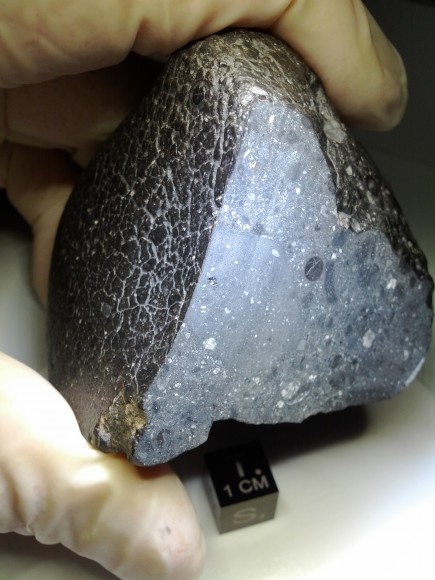Carnegie Institution for Science | 2013 Jan 03
After extensive analyses by a team of scientists led by Carl Agee at the University of New Mexico, researchers have identified a new class of Martian meteorite that likely originated from Mars’s crust. It is also the only meteoritic sample dated to 2.1 billion years ago, the early era of the most recent geologic epoch on Mars, an epoch called the Amazonian. The meteorite was found to contain an order of magnitude more water than any other Martian meteorite. Researchers from the Carnegie Institution (Andrew Steele, Marilyn Fogel, Roxane Bowden, and Mihaela Glamoclija) studied carbon in the meteorite and have shown that organic carbon (macromolecular) similar to that seen in other Martian meteorites is also found in this meteorite. The research is published in the January 3, 2013, issue of Science Express.Northwest Africa (NWA) 7034
Credit: NASA/C. Agee (UNM)
The unique meteorite, dubbed Northwest Africa (NWA) 7034, has some similarities to, but is very different from other Martian meteorites known as SNC (for three members of the group: Shergotty, Nakhla, and Chassigny). SNC meteorites currently number 110. And so far they are the only meteoritic samples from Mars that scientists have been able to study. However, their point of origin on the Red Planet is not known. In fact, recent data from lander and orbiter missions suggest that they are a mismatch for the Martian crust.
As co-author Andrew Steele, who led the carbon analysis at the Carnegie Institution’s Geophysical Laboratory explained: “The texture of the NWA meteorite is not like any of the SNC meteorites. It is made of cemented fragments of basalt, rock that forms from rapidly cooled lava, dominated with feldspar and pyroxene, most likely from volcanic activity. This composition is common for lunar samples, but not from other Martian meteorites. This unusual meteorite’s chemistry suggests it came from the Martian crust. It is the first link thus far of any meteorite to the crust. Our carbon analysis also showed the presence of macromolecular organic carbon in feldspar grains associated with iron oxides, hinting that perhaps there is a different non-biological process at work than that explaining the presence of macromolecular carbon in other Martian meteorites.”
Lead author Agee, of the Institute of Meteoritics at the University of New Mexico, remarked: “The basaltic rock in this meteorite is consistent with the crust or upper mantle of Mars based on findings from recent Martian rovers and orbiters. Our analysis of the oxygen isotopes shows that NWA 7034 is not like any other meteorites or planetary samples. The chemistry is consistent with a surface origin and an interaction with the Martian atmosphere. The abundance of water, some 6000 parts per million, suggests that the meteorite interacted with the Martian surface some 2.1 billion years ago.”
“Perhaps most exciting, is that the high water content could mean there was an interaction of the rocks with surface water either from volcanic magma, or from fluids from impacting comets during that time,” said Steele. “It is the richest Martian meteorite geochemically and further analyses are bound to unleash more surprises.”
Unique Meteorite from Early Amazonian Mars: Water-Rich Basaltic Breccia Northwest Africa 7034 - Carl B. Agee et al
- Science (online 03 Jan 2013) DOI: 10.1126/science.1228858
Researchers Identify Water Rich Meteorite Linked To Mars Crust
NASA | Mars Mission Page | 2012 Jan 03
Signs of Water in Martian Meteorite
Science Shot | Sid Perkins | 2012 Jan 03
Meteorite From Mars is Water-Rich
Universe Today | Nancy Atkinson | 2013 Jan 03
Rare Water-Rich Mars Meteorite Discovered
Discovery News | Irene Klotz | 2013 Jan 03

